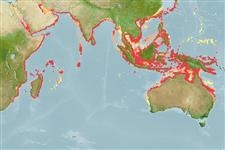Teleostei (teleosts) >
Clupeiformes (Herrings) >
Dorosomatidae (Gizzard shads and sardinellas)
Etymology: Sardinella: Latin and Greek, sarda = sardine; name related to the island of Sardinia; diminutive (Ref. 45335).
More on author: Valenciennes.
Environment: milieu / climate zone / depth range / distribution range
Ecology
Marine; brackish; pelagic-neritic; depth range 0 - 50 m (Ref. 188). Tropical; 31°N - 30°S, 31°E - 155°E (Ref. 188)
Indo-West Pacific: Red Sea, Persian Gulf, East African coasts, Madagascar eastward to Indonesia and the Arafura Sea (Ref. 9819), north to Taiwan and south to Papua New Guinea (Ref. 188).
Length at first maturity / Size / Weight / Age
Maturity: Lm 9.0 range ? - ? cm
Max length : 15.0 cm TL male/unsexed; (Ref. 126292); common length : 10.0 cm SL male/unsexed; (Ref. 188); max. published weight: 35.56 g (Ref. 126292)
Dorsal spines (total): 0; Dorsal soft rays (total): 18 - 20; Anal spines: 0; Anal soft rays: 21 - 23. This species is distinguished by the following characters: body highly compressed, its depth 28.8-33.8% of standard length; interrupted longitudinal striae formation in lateral scales; prepelvic and post-pelvic scutes count 18 + 12-13 (usually 18+12); A 21-23 rays (usually 22); gill rakers 47–64 (Ref. 114969).
Body shape (shape guide): fusiform / normal; Cross section: compressed.
Found in coastal waters (Ref. 30573). Forms schools. Feeds on zooplankton and phytoplankton (Ref. 30573). Marketed fresh, dried, dried-salted, and made into fish balls.
Life cycle and mating behavior
Maturity | Reproduction | Spawning | Eggs | Fecundity | Larvae
Stern, N., B. Rinkevich and M. Goren, 2016. Integrative approach revises the frequently misidentified species of Sardinella (Clupeidae) of the Indo-West Pacific Ocean. J. Fish Biol. 89(5):2282-2305. (Ref. 114969)
IUCN Red List Status (Ref. 130435: Version 2025-1)
Threat to humans
Harmless
Human uses
Fisheries: commercial
Tools
Special reports
Download XML
Internet sources
Estimates based on models
Preferred temperature (Ref.
123201): 24.9 - 29.2, mean 28.2 °C (based on 1450 cells).
Phylogenetic diversity index (Ref.
82804): PD
50 = 0.5000 [Uniqueness, from 0.5 = low to 2.0 = high].
Bayesian length-weight: a=0.00513 (0.00327 - 0.00805), b=2.99 (2.86 - 3.12), in cm total length, based on LWR estimates for this species & Genus-body shape (Ref.
93245).
Trophic level (Ref.
69278): 2.6 ±0.14 se; based on food items.
Resilience (Ref.
120179): High, minimum population doubling time less than 15 months (K=1.10-2.03).
Fishing Vulnerability (Ref.
59153): Low vulnerability (10 of 100).
🛈
Nutrients (Ref.
124155): Calcium = 158 [71, 268] mg/100g; Iron = 1.26 [0.69, 2.23] mg/100g; Protein = 21 [20, 22] %; Omega3 = 0.176 [0.088, 0.367] g/100g; Selenium = 92.7 [41.8, 187.4] μg/100g; VitaminA = 58.7 [16.9, 208.5] μg/100g; Zinc = 1.85 [1.21, 2.78] mg/100g (wet weight); based on
nutrient studies.
